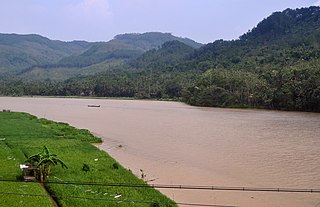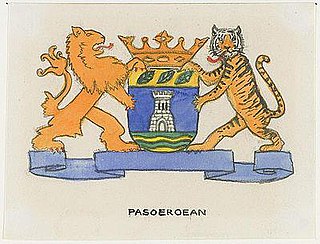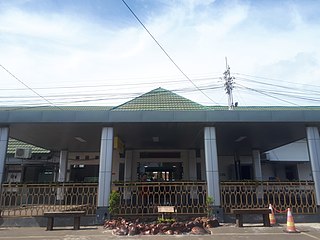
0-6-0 is the Whyte notation designation for steam locomotives with a wheel arrangement of no leading wheels, six powered and coupled driving wheels on three axles, and no trailing wheels. Historically, this was the most common wheel arrangement used on both tender and tank locomotives in versions with both inside and outside cylinders.
Indonesian National Route 9 is a main road which connects Ajibarang and Secang. The route is a middle route which passes Dieng Plateau and located in Central Java.

The Serayu River is a river in Central Java, Indonesia, about 300 km southeast of the capital Jakarta.

Karawang Station (KW) is a railway station located in Nagasari, West Karawang, Karawang Regency. The station, which is located at an altitude of +16 m, is included in the Operation Area I Jakarta and is the station that is located in the westernmost of Karawang Regency.
Most railway lines in Indonesia were constructed during the Dutch colonial rule. After independence in 1945, many lines were abandoned. The current national rail operator, PT Kereta Api Indonesia (Persero), was founded on 28 September 1945.

Semarang Poncol Station (SMC) is a historic railway station in Purwosari, North Semarang, Semarang, Indonesia. The station which is located at an altitude of +3 meters is included in the Semarang Operational Area IV and is the second main station in Semarang after Semarang Tawang Station. It was built in 1914 and is considered an early example of Art Deco architecture.

N.V. Nederlandsch-Indische Spoorweg Maatschappij, abbreviated to NIS, NISM or N.V. NISM was a private-owned railways company in charge of rail transport in Java, Dutch East Indies. The company's headquarters were in Semarang, Central Java. The company started its maiden route from Semarang to the Vorstenlanden and in 1873 they also built their line to the Willem I Railway Station of Ambarawa–Kedungjati and Batavia–Buitenzorg lines. Later the network expanded to Bandung and Surabaya. It was absorbed into the present Kereta Api Indonesia after Indonesian independence in 1949. It was the main competitor to Staatsspoorwegen as state-owned railway company and established on April 6, 1875.

Purwokerto Station (PWT) is a large type A railway station located in West Purwokerto, Banyumas Regency, Central Java, Indonesia. The station is located at an altitude of 75 m. It is the largest station under the management of PT Kereta Api Indonesia (Persero) Operation Area V Purwokerto. As a large station, all trains that pass through the Prupuk–Kroya railway line must stop at this station.

The Madoera Stoomtram Maatschappij on Madura Island today's Indonesian province of Jawa Timur was one of the railway companies in the Dutch East Indies. The company had its headquarters in The Hague and was licensed in 1896. In 1901 it put the first steam trams in operation to connect the western with the eastern end of the island.

The Pasoeroean Stoomtram Maatschappij, N.V. was a private tramway in Pasuruan on the Dutch East Indies. It served passenger transport as well as goods transport of agricultural products such as sugarcane, tea and tobacco.

The Samarang–Joana Stoomtram Maatschappij, N.V. was from 1879 to 1959 a private tram company on the Dutch East Indies, providing passenger and freight trains on a 417 kilometres (259 mi) long network with a gauge of 1,067 mm.

Kroya Station (KYA) is a railway station located in Bajing, Kroya, Cilacap Regency, Central Java, Indonesia. The station has nine railway tracks. It is a major junction station where the line from Yogyakarta split, where one goes to Purwokerto and Cirebon, while other head to Bandung.

Cikampek Station (CKP) is a large class type B railway station located in Cikampek Kota, Cikampek, Karawang Regency. The station, which is located at an altitude of +46 meters, is the station that is located in the easternmost part of the Operational Area I Jakarta and Karawang Regency, and is the largest railway station in Karawang Regency.

There was a tram system in Surabaya, East Java, Indonesia from 1889 to 1978. The tramway was operated by a private company Oost-Java Stoomtram Maatschappij, and later by Kereta Api Indonesia (KAI), and was the only OJS-owned rail system survived in post-independence Indonesia. The tramway linked Ujung with Wonokromo and continued towards Krian in Sidoarjo. All land assets of the tramway is currently owned by Operational Area VII Surabaya of the KAI.

Bangil Station (BG) is a class I (one) railway station located in Pogar, Bangil, Pasuruan Regency; entered within eastern border of Operational Area VII Surabaya of Kereta Api Indonesia (KAI) at the height of ± 9 meters above sea level. To the east of this station, there are branches towards Pasuruan-Probolinggo-Jember-Banyuwangi and to Malang.

Maos Station (MA) is a large type C railway station located in Maos District, Cilacap Regency, Central Java, Indonesia. The station is located at an altitude of +8 meters and is operated by Operation Area V Purwokerto.

Oost-Java Stoomtram Maatschappij (OJS) is the name of a private railway company which once operated in Surabaya, Dutch East Indies. The network had 46 stops with a total of near 66 miles (107 km) track; prior to its demise, it operated between the cities of Surabaya and Sidoarjo, Mojokerto Regency and Jombang Regency, on a mixture of former railway lines and urban on-street running.


















